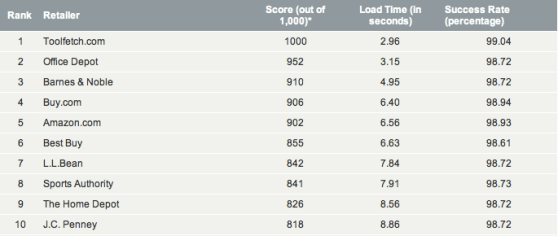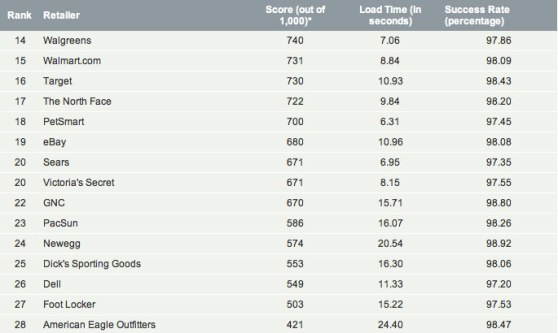 Mobile commerce has been the next big thing for some time now, and it’s not all hype: 16.3 percent of all online Black Friday online sales were consummated over mobile.
Mobile commerce has been the next big thing for some time now, and it’s not all hype: 16.3 percent of all online Black Friday online sales were consummated over mobile.
But there’s a dirty little secret that mobile commerce has been keeping. It’s slow — deadly slow.
Site monitoring and testing company Keynote tracks the speed and reliability of top U.S. e-commerce sites, and over the weekend things slowed down dramatically. Especially today, on Cyber Monday.
“The average page load time for a mobile retail site … on Cyber Monday is now slower than 18 seconds, or roughly twice as slow as normal,” Aaron Rudger, a mobile manager at Keynote, said in a statement.

Above: Fastest mobile sites
That’s almost nine times slower than the average time on top e-commerce companies’ desktop sites: 2.27 seconds. And it’s an eternity while you’re standing there staring at your tiny screen. It’s something I’ve noticed personally even when it’s not Black Friday or Cyber Monday, and even when using fast LTE networks with an iPhone 5 or a Google/Samsung Nexus.
But there’s mobile, and there’s mobile.
Of that 16.3 percent of Black Friday commerce that came in over mobile, the lion’s share — 10 of those 16 percentage points — were purchases made on iPads. Only about a quarter of iPads are sold with cellular connectivity — most are Wi-Fi models. And only a very small fraction, about six percent, of iPad browsing sessions come over cellular networks.
All of which means that iPad numbers are very different from what we typically imagine when we think of “mobile commerce.” iPad-facilitated traffic and sales data gets lumped in with smartphones under the big tent of “mobile,” but the tablet experience of a large screen, beefy processor, and fast local Wi-Fi is very different from a tiny screen, over sometimes-jammed cellular networks, and a generally slower processor.
What that means is: mobile shopping on a phone isn’t exactly the best — or speediest — experience.
“This is quite detrimental and will certainly impact a customer’s experience negatively and can easily motivate a shopper to abandon a site altogether or go to a competitor’s mobile shopping site,” Rudger said.
The solution, according to Keynote, is better sites and better testing, especially testing under load.

Above: Slowest mobile sites
photo credit: Michael W. May via photopin cc


